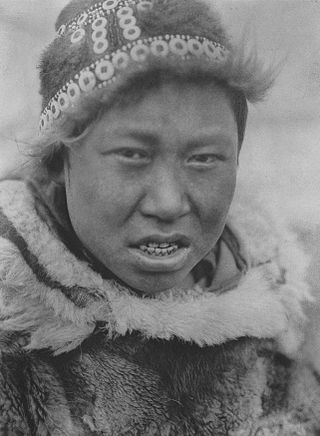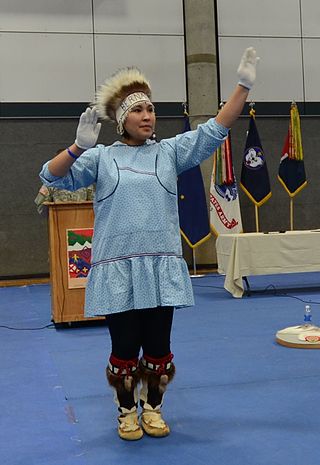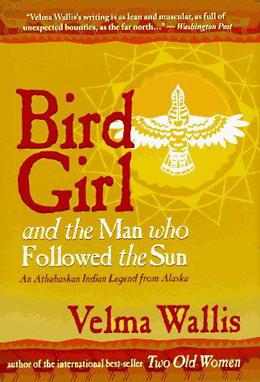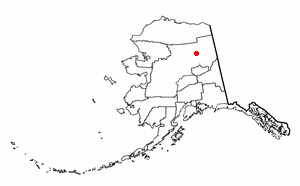
The Yupik are a group of Indigenous or Aboriginal peoples of western, southwestern, and southcentral Alaska and the Russian Far East. They are related to the Inuit and Iñupiat. Yupik peoples include the following:

The Arctic National Wildlife Refuge or Arctic Refuge is a national wildlife refuge in northeastern Alaska, United States, on traditional Iñupiaq and Gwich'in lands. The refuge is 19,286,722 acres (78,050.59 km2) of the Alaska North Slope region, with a northern coastline and vast inland forest, taiga, and tundra regions. ANWR is the largest national wildlife refuge in the country, slightly larger than the Yukon Delta National Wildlife Refuge. The refuge is administered from offices in Fairbanks. ANWR is home to a diverse range of endemic mammal species; notably, it is one of the few North American locations with all three endemic American ursids—the polar bear, grizzly bear, and American black bear, each of which resides predominantly in its own ecological niche. Besides the bears, other mammal species include the moose, caribou, wolves, red and Arctic fox, Canada lynx, wolverine, pine marten, American beaver, and North American river otter. Further inland, mountain goats may be seen near the slope. Hundreds of species of migratory birds visit the refuge yearly, and it is a vital, protected breeding location for them. Snow geese, eiders and snowy owl may be observed as well.

Fort Yukon is a city in the Yukon-Koyukuk Census Area in the U.S. state of Alaska, straddling the Arctic Circle. The population, predominantly Gwich'in Alaska Natives, was 428 at the 2020 census, down from 595 in 2000.

The Iñupiat are a group of Indigenous Alaskans whose traditional territory roughly spans northeast from Norton Sound on the Bering Sea to the northernmost part of the Canada–United States border. Their current communities include 34 villages across Iñupiat Nunaat, including seven Alaskan villages in the North Slope Borough, affiliated with the Arctic Slope Regional Corporation; eleven villages in Northwest Arctic Borough; and sixteen villages affiliated with the Bering Straits Regional Corporation. They often claim to be the first people of the Kauwerak.

A sled dog is a dog trained and used to pull a land vehicle in harness, most commonly a sled over snow.

Alaska Natives are the Indigenous peoples of Alaska and include Iñupiat, Yupik, Aleut, Eyak, Tlingit, Haida, Tsimshian, and a number of Northern Athabaskan cultures. They are often defined by their language groups. Many Alaska Natives are enrolled in federally recognized Alaska Native tribal entities, who in turn belong to 13 Alaska Native Regional Corporations, who administer land and financial claims.

The Gwichʼin language belongs to the Athabaskan language family and is spoken by the Gwich'in First Nation (Canada) / Alaska Native People. It is also known in older or dialect-specific publications as Kutchin, Takudh, Tukudh, or Loucheux. Gwich'in is spoken primarily in the towns of Inuvik, Aklavik, Fort McPherson, and Tsiigehtchic, all in the Northwest Territories and Old Crow in Yukon of Canada. In Alaska of the United States, Gwichʼin is spoken in Beaver, Circle, Fort Yukon, Chalkyitsik, Birch Creek, Arctic Village, Eagle, and Venetie.

The Gwichʼin are an Athabaskan-speaking First Nations people of Canada and an Alaska Native people. They live in the northwestern part of North America, mostly north of the Arctic Circle.

The Porcupine River is a 916 km (569 mi) tributary of the Yukon River in Canada and the United States. It rises in the Ogilvie Mountains north of Dawson City, Yukon, Canada. From there it flows north through the community of Old Crow, veers southwest into the U.S. state of Alaska, and enters the larger river at Fort Yukon, Alaska. It derives its name from the Gwich'in word for the river, Ch'oonjik, or "Porcupine Quill River".

Prehistoric Alaska begins with Paleolithic people moving into northwestern North America sometime between 40,000 and 15,000 years ago across the Bering Land Bridge in western Alaska; a date less than 20,000 years ago is most likely. They found their passage blocked by a huge sheet of ice until a temporary recession in the Wisconsin glaciation opened up an ice-free corridor through northwestern Canada, possibly allowing bands to fan out throughout the rest of the continent. Eventually, Alaska became populated by the Inuit and a variety of Native American groups. Trade with both Asia and southern tribes was active even before the advent of Europeans.

The Yupʼik or Yupiaq and Yupiit or Yupiat (pl), also Central Alaskan Yupʼik, Central Yupʼik, Alaskan Yupʼik, are an Indigenous people of western and southwestern Alaska ranging from southern Norton Sound southwards along the coast of the Bering Sea on the Yukon-Kuskokwim Delta and along the northern coast of Bristol Bay as far east as Nushagak Bay and the northern Alaska Peninsula at Naknek River and Egegik Bay. They are also known as Cup'ik by the Chevak Cup'ik dialect-speaking people of Chevak and Cup'ig for the Nunivak Cup'ig dialect-speaking people of Nunivak Island.

Chief David Salmon was an indigenous Alaskan that served as Chief of Chalkyitsik and later First Traditional Chief for the Gwich'in people. He was known for his commitment to improving his community and working for the people. Salmon would use his position and influence as chief to begin many public works and create programs dedicated to helping the Gwich'in people. As an advocate for education, Salmon would spread his knowledge by creating traditional Athabascan items for display or teaching his community to keep Athabascan traditions alive. At the same time, Chief Salmon would be trained and become the first Episcopal priest for Interior Alaska and spend a lot of his life spreading his faith.
Velma May Wallis is a Native American writer of Gwich'in Athabascan Indian descent. Her books have been translated into 17 languages.

Bird Girl and the Man Who Followed the Sun is a 1996 novel by Velma Wallis. It describes the lives of two Gwich'in Athabaskans, Daagoo and Bird Girl, who each defy the rules of their culture and strike out on their own.

Gwichyaa Gwichʼin are a Gwich'in people who live in the Yukon Flats area of Alaska, USA. This includes the Fort Yukon area on both banks of the Yukon River from Birch Creek to Porcupine River;" the Senati 65.266°N 151.183°W area of the middle Yukon River, the namesake of Sahneuti, Gwich'in chief and fur trader; and Venetie.
Alaska Natives are a group of indigenous people that live in the state of Alaska and trace their heritage back to the last two great migrations that occurred thousands of years ago. The Native community can be separated into six large tribes and a number of smaller tribes, including the Iñupiat, Yup'ik, Aleut, Tlingit, Haida, Tsimshian, and others. Even with just a small number of communities that make up the entire population, there were more than 300 different languages that the Natives used to communicate with one another.
Western States Book Award honored notable works of fiction, creative nonfiction, poetry, and translation written and published in the Western United States. The award was given annually from 1984 until 2002. Lifetime-achievement awards were also presented.

The Tanana Athabaskans, Tanana Athabascans or Tanana Athapaskans are an Alaskan Athabaskan peoples of the Athabaskan-speaking ethnolinguistic group. They are the original inhabitants of the Tanana River drainage basin in east-central Alaska Interior, United States and a little part lived in Yukon, Canada. Tanana River Athabaskan peoples are called in Lower Tanana and Koyukon language Ten Hʉt'ænæ, in Gwich'in language Tanan Gwich'in. In Alaska, where they are the oldest, there are three or four groups identified by the languages they speak. These are the Tanana proper or Lower Tanana and/or Middle Tanana, Tanacross or Tanana Crossing, and Upper Tanana. The Tanana Athabaskan culture is a hunter-gatherer culture and have a matrilineal system. Tanana Athabaskans were semi-nomadic and as living in semi-permanent settlements in the Tanana Valley lowlands. Traditional Athabaskan land use includes fall hunting of moose, caribou, Dall sheep, and small terrestrial animals, and also trapping. The Athabaskans did not have any formal tribal organization. Tanana Athabaskans were strictly territorial and used hunting and gathering practices in their semi-nomadic way of life and dispersed habitation patterns. Each small band of 20–40 people normally had a central winter camp with several seasonal hunting and fishing camps, and they moved cyclically, depending on the season and availability of resources.
Athabaskan fiddle is the old-time fiddle style that the Alaskan Athabaskans of the Interior Alaska have developed to play the fiddle (violin), solo and in folk ensembles. Fiddles were introduced in this area by Scottish, Irish, French Canadian, and Métis fur traders of the Hudson's Bay Company in the mid-19th century. Athabaskan fiddling is a variant of fiddling of the American southlands. Athabaskan fiddle music is most popular genre in Alaska and northwest Canada and featuring Gwich'in Bill Stevens and Trimble Gilbert.

Hannah Paul Solomon was an American community leader and artist. She was the first female mayor of Fort Yukon, Alaska, helped organize the Fairbanks Native Association, and was inducted into the Alaska Women's Hall of Fame in 2012. Her traditional beadwork is in the collections of several museums.















